Key Competencies Kit
for Facing Lifelong Learning


 |
This Project has been funded with support from the European Commission. This communication reflects the views only of the author, and the Commission can not be held responsible for any use which may be made of the information contained therein. |
 |
Didactic Unit 4 |
Theme |
Time |
Think and solve problems |
|
3 hours |
|
||
|
||
check to see if solution works and act on opportunities for improvement; |
A person cannot solve a problem until he/she clearly understands and identifies the real problem.
Some of our problems and decisions are simple, like deciding where to have lunch when our usual place is closed. However, some problems are challenging and take careful thought and consideration. When we are confronted with these types of problems, it can be very difficult to decide on the best solution.
However, researchers have developed a technique that many people have found useful when they are trying to solve a problem that seems unsolvable.
This procedure involves a series of steps that you can go through on your own when you are confronted with a problem that needs to be solved. This approach may not work perfectly for all difficulties, but it may help with many of the problems you are confronted with in your life.
Step 1: Problem identification This step involves recognizing that a problem exists and that solving it possible. It is important that you approach the problem solving process with a positive attitude and view the problem solving as an opportunity or challenge.
You need to be at work in an hour. If "Somebody can't drive you to work" will it be a problem or not? It may or may not be a problem depending on many other factors. Rephrasing the problem to "How will I get to work?" puts the focus of the problem-solving on getting to work rather than on the fact that somebody can not help you to do this. |
Step 2: Problem definition. Before you start to tackle the current problem, it is important to clearly understand the difficulty and make sure that the problem you are trying to solve is the "real" problem.
That is, sometimes people find a different problem than the one that is really distressing them, and focus on this one, since it is easier than dealing with the real problem. This step really involves your thinking about the difficulty you are having, understanding the problem, and understanding why the situation is distressing.
Some people think of problems as a difference between what they want and what the current situation is like. It is useful during this stage to think about how the current situation is different from how you would like it to be. If you are currently facing many difficult decisions, it may be helpful to prioritize those problems and deal with them one at a time.
Also the fact that somebody can't drive you to work may not be a problem at all if you have other alternatives. Or if you got this information several days ago, for example, not just before going to work. So you have enough time to organise alternative transportation. A correct definition of a real problem is "I have to be to work in 1 hour, my usual ride is not available, and the next bus won't get me to work on time." |
Step 3: Generation of alternative solutions. During this stage, you should ask yourself, "What have I done in this situation in the past, and how well has that worked?" If you find that what you have done in the past has not been as effective as you would like, it would be useful to generate some other solutions that may work better.
When you start to think of possible solutions, do not limit yourself; think of as many possible options as you can, even if they seem unrealistic.
You remember that once you had a similar problem and solved it by calling your colleague who passess by on his way to work and can pick you up. There is a risk, however, that he may already be on the way, or that there are no free place in his car. Another solution may be calling a taxi. However taking a taxi from home may be risky because there are traffic jams on the way and taxi may come later that expected. One more possible solution is to walk and then take a taxi from different place where there are few traffic jams.
|
Step 4: Decision making Now you are ready to narrow down some of the options that you have generated in the previous step.
For example, if your solution costs a great deal of money or requires many hours of effort each day, this may be too difficult to implement.
As you start to narrow down your choices, remember, no problem solution is perfect and all will have drawbacks, but you can always revise the solution if it does not work the way you want it to work.
After thinking over possible solutions and taking several steps to check them (call a colleague and find out that his phone is busy; estimate how long will it take to walk and then to take taxi) you decide to take taxi from home. Although, this decision is more costly that alternatives it will solve problem in a best way. |
An objective criteria allows everyone to focus on better solutions. It also allows people to be able to change their minds flexibly.
Step 5: Solution implementation and verification Once you have decided on solution that seems to solve your problem, it is time to test it out. Make sure that when you implement this solution, you do so whole-heartedly and give it your best effort.
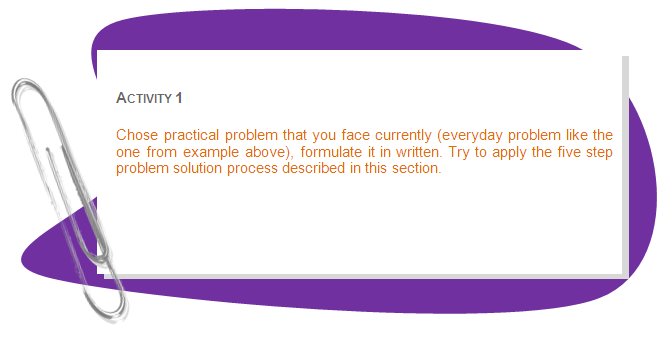
The key to successful problem solving starts within our own minds. It means that we should not only just "think" about a conflict or a problem. We should analyse many factors and make numerous „small“ decisions that in the end contribute to the solution of a problem.
Important preconditions for successful problem solving:
1. Keep your mind open. When your mind is open to new ideas you can generate more decisions and solve your problem in a best way.

2. Perceive situation or a problem as positive as possible.
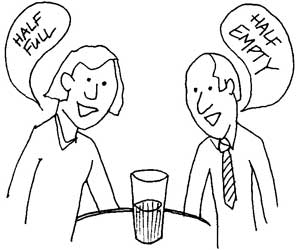
Understanding your perceptions will help open ways to finding solutions
.
3. Take into account emotions
Sometimes a problem may evoke intense emotions. Until the emotional aspects of a problem are resolved, it is usually difficult to address the substantive ones.
If there are particularly strong feelings about a particular problem, it may be necessary to go beyond its acknowledgment and to suspend decision making and try to cool down and reduce emotions.

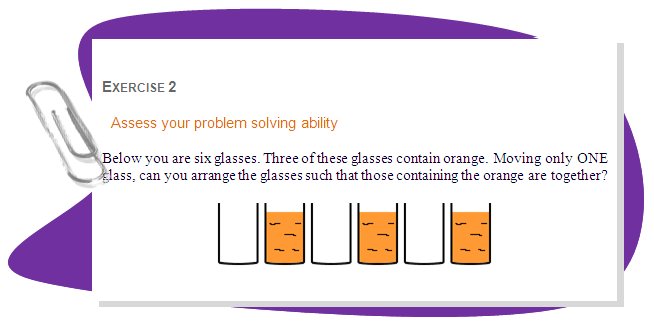
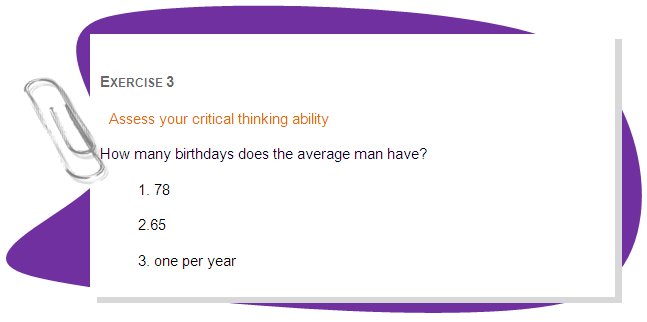
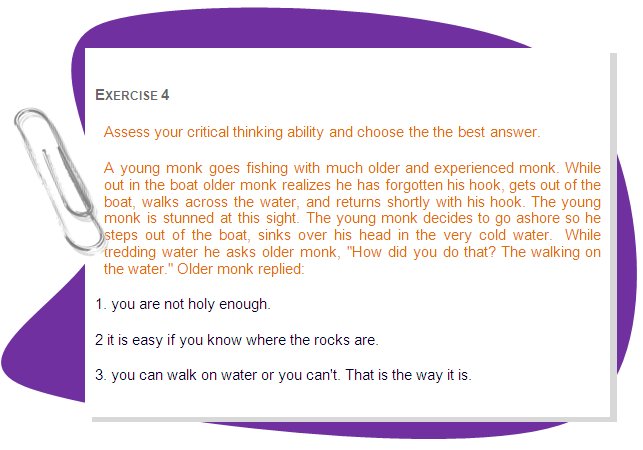
 |
Answers to the questions and exercises of Didactic Unit 4 |
3.
Simply take the second glass and pour the orange into the fifth glass
3.
2.